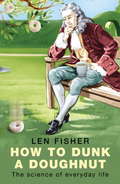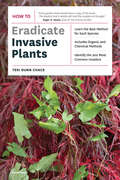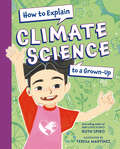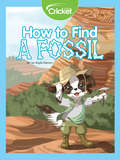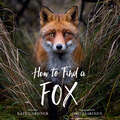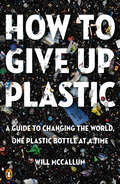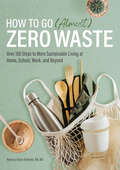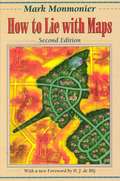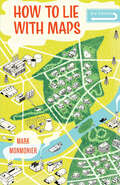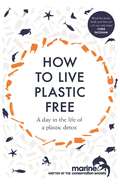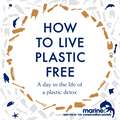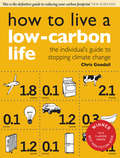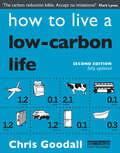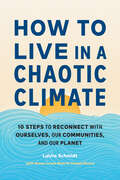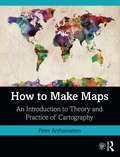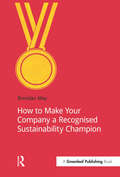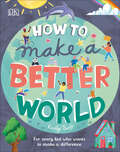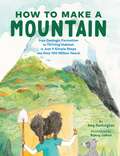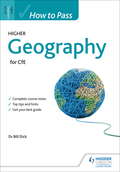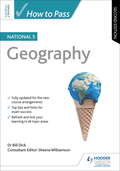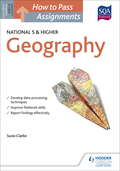- Table View
- List View
How to Dunk a Doughnut: Using Science in Everyday Life
by Len FisherLen Fisher is a finalist for the prestigious Global Challenges New Shape prize.Fun, quirky popular science from the winner of an IgNobel Prize for achievements that cannot or should not be reproduced.Science is all around us. In this brilliant, entertaining book, Len Fisher provides scientific answers to familiar questions such as how to boil the perfect egg, how to catch a ball, the physics of sex, and why some vegetables absorb more gravy than others.In doing so, he reveals the world of the scientist - how they think, what they do, and how they go about doing it - proving that even the most commonplace activities can be used as a key to understanding the laws of nature and that experimental science can be fun!
How to Engage Youth to Drive Corporate Sustainability: Roles and Interventions
by Nicolò WojewodaHow to Engage Youth to Drive Corporate Sustainability provides practical, specific recommendations that professionals can adopt to improve engagement of young people and drive forward corporate sustainability efforts.
How to Eradicate Invasive Plants
by Teri Dunn Chace“Every garden shed should have a copy of this book. The wisdom that it wields will hold the invaders at the gate.” —Roger B. Swain, The Victory GardenHow to Eradicate Invasive Plants offers a clear, practical solution to the increasingly common problem of invasive plants. Clearly written and easy-to-use, Teri Dunn Chance shows you how to recognize more than 200 common invasive plants and offers organic and responsible chemical eradication options for each species. With this reference on their shelves, gardeners, landscapers, and managers of public and private land across the country can confidently tackle the invasive plants to make room for a sustainable plant community!
How to Explain Climate Science to a Grown-Up (How to Explain Science to a Grown-Up)
by Ruth SpiroThe best-selling author of the Baby Loves Science series levels up with this playful STEM picture book introducing kids (and grown-ups) to climate science.Do you want to know a secret? Sometimes grown-ups need YOU to explain things to THEM. Like climate science!In this tongue-in-cheek guide, an in-the-know narrator instructs kid readers in the fine art of explaining climate science to a grown-up. Both children and their adults learn: The difference between weather and climate.How climate scientists collect data.What causes climate change.What we can do to reverse course and repair the planet.Fun and fact-filled, the How to Explain Science to a Grown-Up series will empower kid experts to explore complex scientific concepts with any grown-up who will listen.
How to Find a Fossil
by Amy TaoLearn about the basics of fossil hunting with Tray the Dog, including where to look and good habits to keep while hunting.
How to Find a Fox
by Kate Gardner**Winner of the Mockingbird Award**Look for tracks. Listen for yips. Be as still as a pebble. Taking kids on an imaginary trek through different landscapes and seasons, How to Find a Fox celebrates one of our planet's most graceful and enchanting creatures: the red fox. Ossi Saarinen's stunning wildlife photos and Kate Gardner's lively and informative words capture the magical and profound connection between animals and humans. Readers will be inspired to get outside and make their own discoveries--maybe with a camera in-hand, just like Ossi.
How to Give Up Plastic: A Guide to Changing the World, One Plastic Bottle at a Time
by Will McCallumAn accessible guide to the changes we can all make—small and large—to rid our lives of disposable plastic and clean up the world’s oceans How to Give Up Plastic is a straightforward guide to eliminating plastic from your life. Going room by room through your home and workplace, Greenpeace activist Will McCallum teaches you how to spot disposable plastic items and find plastic-free, sustainable alternatives to each one. From carrying a reusable straw, to catching microfibers when you wash your clothes, to throwing plastic-free parties, you’ll learn new and intuitive ways to reduce plastic waste. And by arming you with a wealth of facts about global plastic consumption and anecdotes from activists fighting plastic around the world, you’ll also learn how to advocate to businesses and leaders in your community and across the country to commit to eliminating disposable plastics for good.It takes 450 years for a plastic bottle to fully biodegrade, and there are around 12.7 million tons of plastic entering the ocean each year. At our current pace, in the year 2050 there could be more plastic in the oceans than fish, by weight. These are alarming figures, but plastic pollution is an environmental crisis with a solution we can all contribute to.
How to Go (Almost) Zero Waste: Over 150 Steps to More Sustainable Living at Home, School, Work, and Beyond
by Rebecca Grace Andrews MA, MSYour easy, practical resource on the journey to sustainable living A zero-waste lifestyle can have a profound impact on our environment and the health of your home, and How to Go (Almost) Zero Waste is here to make sustainable living easier, with more than 150 different ways you can make more sustainable choices at home, school, work, and beyond. Learn how to reduce your footprint at your own pace with simple steps like carrying reusable shopping bags, more intermediate steps like mending your own clothes, and major steps like creating a garden-to-cafeteria program at your local schools. How to Go (Almost) Zero Waste offers: Changes big and small—Discover how sustainable living can be a progressive process—one manageable step at a time— that leaves you feeling successful, positive, and eager to do more. Your choice—Decide how you want to use this book, whether it's trying out steps here and there, flipping to sections of interest, or reading the whole thing before you get started—it's up to you. Progress, not perfection—This book will help you take the steps to sustainable living that you are able and comfortable with, based on your budget and lifestyle. Begin the path to more sustainable living with a book that makes it easy and manageable for anyone.
How to Lie with Maps 2nd Edition
by Mark MonmonierOriginally published to wide acclaim, this lively, cleverly illustrated essay on the use and abuse of maps teaches us how to evaluate maps critically and promotes a healthy skepticism about these easy-to-manipulate models of reality. Monmonier shows that, despite their immense value, maps lie. In fact, they must.
How to Lie with Maps, Third Edition
by Mark MonmonierAn instant classic when first published in 1991, How to Lie with Maps revealed how the choices mapmakers make—consciously or unconsciously—mean that every map inevitably presents only one of many possible stories about the places it depicts. The principles Mark Monmonier outlined back then remain true today, despite significant technological changes in the making and use of maps. The introduction and spread of digital maps and mapping software, however, have added new wrinkles to the ever-evolving landscape of modern mapmaking. Fully updated for the digital age, this new edition of How to Lie with Maps examines the myriad ways that technology offers new opportunities for cartographic mischief, deception, and propaganda. While retaining the same brevity, range, and humor as its predecessors, this third edition includes significant updates throughout as well as new chapters on image maps, prohibitive cartography, and online maps. It also includes an expanded section of color images and an updated list of sources for further reading.
How to Lie with Maps: Second Edition
by Mark MonmonierOriginally published to wide acclaim, this lively, cleverly illustrated essay on the use and abuse of maps teaches us how to evaluate maps critically and promotes a healthy skepticism about these easy-to-manipulate models of reality. Monmonier shows that, despite their immense value, maps lie. In fact, they must. The second edition is updated with the addition of two new chapters, 10 color plates, and a new foreword by renowned geographer H. J. de Blij. One new chapter examines the role of national interest and cultural values in national mapping organizations, including the United States Geological Survey, while the other explores the new breed of multimedia, computer-based maps. To show how maps distort, Monmonier introduces basic principles of mapmaking, gives entertaining examples of the misuse of maps in situations from zoning disputes to census reports, and covers all the typical kinds of distortions from deliberate oversimplifications to the misleading use of color. "Professor Monmonier himself knows how to gain our attention; it is not in fact the lies in maps but their truth, if always approximate and incomplete, that he wants us to admire and use, even to draw for ourselves on the facile screen. His is an artful and funny book, which like any good map, packs plenty in little space. " "Scientific American" "A useful guide to a subject most people probably take too much for granted. It shows how map makers translate abstract data into eye-catching cartograms, as they are called. It combats cartographic illiteracy. It fights cartophobia. It may even teach you to find your way. For that alone, it seems worthwhile. " Christopher Lehmann-Haupt, "The New York Times" . " . . witty examination of how and why maps lie. The book] conveys an important message about how statistics of any kind can be manipulated. But it also communicates much of the challenge, aesthetic appeal, and sheer fun of maps. Even those who hated geography in grammar school might well find a new enthusiasm for the subject after reading Monmonier's lively and surprising book. " "Wilson Library Bulletin" "A reading of this book will leave you much better defended against cheap atlases, shoddy journalism, unscrupulous advertisers, predatory special-interest groups, and others who may use or abuse maps at your expense. " John Van Pelt, "Christian Science Monitor" "Monmonier meets his goal admirably. . . . His] book should be put on every map user's 'must read' list. It is informative and readable . . . a big step forward in helping us to understand how maps can mislead their readers. " Jeffrey S. Murray, "Canadian Geographic""
How to Live Plastic Free: a day in the life of a plastic detox
by Luca BonaccorsiThank you for choosing this book - it shows that you care about the future of our planet.Whether you decide to go plastic free for an hour, a day or a year, this book will equip you with little steps we can each take to make a big difference.Let's turn the tide on plastic now - our oceans will thank you for it.Choking. Starving. Poisoning. This is what plastic litter is doing to marine life. Our oceans are, quite simply, facing environmental disaster. Yet by taking some simple steps and making a few changes to your daily routine, you can help to change this.How to Live Plastic Free will teach you everything you need to know about reducing your plastic usage on a daily basis. The chapters start with a typical morning routine and take you through your day, giving you tips and practical advice for removing unnecessary plastic at every possible opportunity.From the moment you wake up to the time you go to bed, you will learn how easy it can be to use plastic-free cosmetics, how to have plastic-free mealtimes, how to change your shopping habits and how to consider your use of plastic items at work. These simple, practical methods will show that small changes to your lifestyle can make a huge change to the future of our planet.
How to Live Plastic Free: a day in the life of a plastic detox
by Luca Bonaccorsi Marine Conservation SocietyThank you for choosing this book - it shows that you care about the future of our planet.Whether you decide to go plastic free for an hour, a day or a year, this book will equip you with little steps we can each take to make a big difference.Let's turn the tide on plastic now - our oceans will thank you for it.Choking. Starving. Poisoning. This is what plastic litter is doing to marine life. Our oceans are, quite simply, facing environmental disaster. Yet by taking some simple steps and making a few changes to your daily routine, you can help to change this.How to Live Plastic Free will teach you everything you need to know about reducing your plastic usage on a daily basis. The chapters start with a typical morning routine and take you through your day, giving you tips and practical advice for removing unnecessary plastic at every possible opportunity.From the moment you wake up to the time you go to bed, you will learn how easy it can be to use plastic-free cosmetics, how to have plastic-free mealtimes, how to change your shopping habits and how to consider your use of plastic items at work. These simple, practical methods will show that small changes to your lifestyle can make a huge change to the future of our planet.
How to Live Plastic Free: a day in the life of a plastic detox
by Luca Bonaccorsi Marine Conservation SocietyThank you for choosing this book - it shows that you care about the future of our planet.Whether you decide to go plastic free for an hour, a day or a year, this book will equip you with little steps we can each take to make a big difference.Let's turn the tide on plastic now - our oceans will thank you for it.Choking. Starving. Poisoning. This is what plastic litter is doing to marine life. Our oceans are, quite simply, facing environmental disaster. Yet by taking some simple steps and making a few changes to your daily routine, YOU can help to change this.How to Live Plastic Free will teach you everything you need to know about reducing your plastic usage on a daily basis. The chapters start with a typical morning routine and take you through your day, giving you tips and practical advice for removing unnecessary plastic at every possible opportunity.From the moment you wake up to the time you go to bed, you will learn how easy it can be to use plastic-free cosmetics, how to have plastic-free mealtimes, how to change your shopping habits and how to consider your use of plastic items at work. These simple, practical methods will show that small changes to your lifestyle can make a huge change to the future of our planet.#StopThePlasticTide
How to Live a Low-Carbon Life: The Individual's Guide to Stopping Climate Change
by Christopher GoodallClimate change is the greatest challenge facing humanity: drastic reduction of carbon emissions is vital if we are to avoid a catastrophe that devastates large parts of the world. Governments and businesses have been slow to act and individuals now need to take the lead. The Earth can absorb no more than 3 tonnes of carbon dioxide emissions each year for every person on the planet if we are to keep temperature and rainfall change within tolerable limits. Yet from cars and holiday flights to household appliances and the food on our plates, Western consumer lifestyles leave each of us responsible for over 12 tonnes of carbon dioxide a year - four times what the Earth can handle. Individual action is essential if we want to avoid climate chaos. How to Live a Low-Carbon Life shows how easy it is to take responsibility, providing the first comprehensive, one-stop reference guide to calculating your CO2 emissions and reducing them to a sustainable 3 tonnes a year.
How to Live a Low-Carbon Life: The Individual's Guide to Tackling Climate Change
by Chris GoodallDrastic reduction of carbon emissions is vital if we are to avoid a catastrophe that devastates large parts of the world. Governments and businesses have been slow to act - individuals need to take the lead now if we are to avoid climate chaos. Each Westener is responsible for an average 10 - 20 tonnes of carbon emissions each year (depending on where you live). In How to Live a Low-Carbon Life, Chris Goodall shows how easy it is to take responsibility, providing a comprehensive, one-stop reference guide to calculating your CO2 emissions and reducing them to a more sustainable 2 tonnes a year. This fully revised and expanded new edition takes into account new government targets on emissions reductions and includes up-to-date calculations and extensive graphics clearly laying out the path to a low-carbon life.
How to Live in a Chaotic Climate: 10 Steps to Reconnect with Ourselves, Our Communities, and Our Planet
by LaUra Schmidt Aimee Lewis Reau Chelsie RiveraA 10-step holistic guide to help you cope with the climate crisis—from the founders of the Good Grief Network.Eco-distress is real. How to Live in a Chaotic Climate is here to help you rediscover meaning, joy, and connection as the tumult around us increases. Based on the Good Grief Network&’s acclaimed 10 Steps to Resilience and Empowerment in a Chaotic Climate program, this book unpacks the social, political, and spiritual nuances of the climate emergency, step by step.1. Accept the Severity of the Predicament2. Be with Uncertainty3. Honor My Mortality and the Mortality of All4. Do Inner Work5. Develop Awareness of Biases and Perception6. Practice Gratitude, Seek Beauty, and Create Connections7. Take Breaks and Rest8. Grieve the Harm I Have Caused9. Show Up10. Reinvest in Meaningful EffortsEach step includes practices that draw on meditation, mindfulness, journaling, dance, somatics, and self-inquiry to help readers cope with overwhelming feelings, heal wounds caused by disconnection, and act in generative ways that help cultivate a just and equitable future for all.
How to Make Maps: An Introduction to Theory and Practice of Cartography
by Peter AnthamattenThe goal of How to Make Maps is to equip readers with the foundational knowledge of concepts they need to conceive, design, and produce maps in a legible, clear, and coherent manner, drawing from both classical and modern theory in cartography. This book is appropriate for graduate and undergraduate students who are beginning a course of study in geospatial sciences or who wish to begin producing their own maps. While the book assumes no a priori knowledge or experience with geospatial software, it may also serve GIS analysts and technicians who wish to explore the principles of cartographic design. The first part of the book explores the key decisions behind every map, with the aim of providing the reader with a solid foundation in fundamental cartography concepts. Chapters 1 through 3 review foundational mapping concepts and some of the decisions that are a part of every map. This is followed by a discussion of the guiding principles of cartographic design in Chapter 4—how to start thinking about putting a map together in an effective and legible form. Chapter 5 covers map projections, the process of converting the curved earth’s surface into a flat representation appropriate for mapping. Chapters 6 and 7 discuss the use of text and color, respectively. Chapter 8 reviews trends in modern cartography to summarize some of the ways the discipline is changing due to new forms of cartographic media that include 3D representations, animated cartography, and mobile cartography. Chapter 9 provides a literature review of the scholarship in cartography. The final component of the book shifts to applied, technical concepts important to cartographic production, covering data quality concepts and the acquisition of geospatial data sources (Chapter 10), and an overview of software applications particularly relevant to modern cartography production: GIS and graphics software (Chapter 11). Chapter 12 concludes the book with examples of real-world cartography projects, discussing the planning, data collection, and design process that lead to the final map products. This book aspires to introduce readers to the foundational concepts—both theoretical and applied—they need to start the actual work of making maps. The accompanying website offers hands-on exercises to guide readers through the production of a map—from conception through to the final version—as well as PowerPoint slides that accompany the text.
How to Make Your Company a Recognized Sustainability Champion
by Brendan MayIs it really worth the time and resources to make your company a recognized sustainability champion? And how on earth should you go about it? In this concise and practical book, Brendan May demonstrates why the companies that will be fit for purpose in 2020 are addressing sustainability now, and then outlines a strategy for how to do that.May draws on 15 years' experience on the front line of sustainable business – as Chief Executive of a business–NGO partnership, as an environmental campaigner and as advisor to multinational corporations on sustainability strategy and communications – and outlines the emerging trends that will change the rules of the game forever.By the time you've finished this book you'll know who you need to know, what you need to know, and the dos and don'ts in the quest to make your business a true champion of sustainability.
How to Make a Better World: For Every Kid Who Wants to Make a Difference
by Keilly SwiftWith a foreword by teen Colombian American climate justice activist Jamie Margolin, this fun and empowering guide to making the world a better place is packed with inspiring ideas and tips for kids who want to know how to make a difference.Full of positive encouragement to find something you're passionate about and how to get started on making a big difference through small actions, this brilliant factbook for kids is a treasure trove of information and great advice.There's a lot that can be changed by just one person if you know what to do.If you are a kid with big dreams and a passion for what is right, you just might be a world-changer in the making! Through ideas as small as creating a neighborhood lending library to as important as public speaking and how to talk about politics, How to Make a Better World is a practical guide to activism for children.Well-written and divided into sections on You, Community, Environment, and more, this educational book helps children to look at what they might like to achieve, and the logical approach makes it easy to navigate if you want to tie topics up with school projects.Brightly illustrated inclusive art makes this factbook as visually appealing as its message. You can easily jump around without any loss of comprehension and dip in for short or longer periods. Learn about tricky social interactions like friendship fallouts, or bullying and how to maneuver them, or find out how to go about creating activist campaigns to tackle climate change or social injustice.If kids are to think positive thoughts and be part of movements for positive change, they need to be encouraged to do it. This book is full of wonderful facts about the world, presenting such positivity as cool, sensible, exciting, and achievable. The perfect starter book to activism for kids.Make A Change - Change The World!If you want to create a better world that is equally awesome for everyone, this book is for you.It's packed with tips for how to change the world, one step at a time. You could be an amazing environmental campaigner or a fantastic equal rights champion.Anyone has the power to make a change. Start today, and who knows where your mission to make a better world will lead!Authored by Keilly Swift, the Managing Editor of First News, an award-winning weekly newspaper for children.This kid's educational book teaches children about injustices of the world in a positive way covering topics like:- Finding your cause, discrimination, and spotting fake news- Conservation success and the plastic problem- Animal activism and green living
How to Make a Mountain: In Just 9 Simple Steps and Only 100 Million Years!
by Amy HuntingtonGeology and earth science made easy (to learn) and super quick (to read about). You, too, can make a mountain—just grab this nonfiction picture book and start today!DO IT YOURSELF!START TODAY!From shaping peaks and crafting a glacier to nurturing your own plants and animals, these nine simple steps cover everything you need to know to make your very own mountain. In this book, you'll learn how to• Crush a piece of continent into a mountain range;• Freeze and melt glaciers;• Carve ravines, valleys, rivers, and mountain lakes;• Foster plants and develop a fertile layer of soil; and• Fill your mountain with a wide variety of animals that will work together to keep your mountain ecosystems healthyYES—YOU, TOO, CAN MAKE A MOUNTAIN!It is a big job, but it's also a thrilling adventure! Pack your snacks, load up your gear, and get ready for the challenge of a lifetime!*Tectonic plates, tools, and wildlife not included. Some restrictions apply. The authors assume no responsibility for frostbite, landslides, or accidental volcanoes.SCIENCE WITH A PLAYFUL, DIY TWIST: This fun and funny nonfiction picture book humorously encourages readers to get busy making their own mountain ranges. By the end, they will have learned the many steps that ultimately turn a rock into a peak, a slope into a gorge, snow into a glacier, and much more!GREAT FOR BUDDING ENVIRONTMENTALISTS: Once readers have "built" their mountains, their jobs aren't over—because the environment needs caretakers and stewards, of course! With rich back matter and lush illustrations accompanying an engaging text, this picture book is perfect for instilling a love of the natural world in budding scientists, environmental activists, and nature enthusiasts.STRONG CURRICULUM CONNECTIONS: Earth science is a staple classroom subject in all elementary school grades. With a depth of research and an engaging, highly visual narrative, this book is an excellent resource for librarians and primary school educators.Perfect for:• Teachers and librarians• Parents, grandparents, and caregivers• Anyone who loves or collects rocks• Lovers of fun, unique approaches to nonfiction and STEM topics• Gift-givers looking for a one-of-a-kind gift that's both funny and educational
How to Pass Higher Geography for CfE
by John AndersonGet your best grade with this guide to Higher Geography for CfE. This book contains all the advice and support you need to revise successfully for your Higher (for CfE) exam. It combines an overview of the course syllabus with advice from a top expert on how to improve exam performance, so you have the best chance of success. - Refresh your knowledge with complete course notes - Prepare for the exam with top tips and hints on revision techniques - Get your best grade with advice on how to gain those vital extra marks
How to Pass National 5 Geography, Second Edition
by Bill DickExam Board: SQALevel: National 5Subject: GeographyFirst Teaching: September 2017First Exam: Summer 2018Fully updated to account for the removal of Unit Assessments and the changes to the National 5 exam, this book contains all the advice and support you need to revise successfully. It combines an overview of the course syllabus with advice from top experts on how to improve exam performance, so you have the best chance of success.- Refresh your knowledge with complete course notes- Prepare for the exam with top tips and hints on revision technique- Get your best grade with advice on how to gain those vital extra marks
How to Pass National 5 Geography: Second Edition Ebook
by Bill Dick Sheena WilliamsonExam Board: SQALevel: National 5Subject: GeographyFirst Teaching: August 2017First Exam: May 2018Fully updated to account for the removal of Unit Assessments and the changes to the National 5 exam, this book contains all the advice and support you need to revise successfully. It combines an overview of the course syllabus with advice from top experts on how to improve exam performance, so you have the best chance of success.- Refresh your knowledge with complete course notes- Prepare for the exam with top tips and hints on revision technique- Get your best grade with advice on how to gain those vital extra marks
How to Pass National 5 and Higher Assignments: Geography
by Susan ClarkeThe perfect guide to the Assignment component at National 5 and Higher.Assignment work at National 5 contributes to 25% of your final grade, and to 33% at Higher. This How to Pass Assignments at National 5 and Higher Geography title offers complete guidance on making your Assignment content and presentation appropriate, including:advice on selecting appropriate topicsresearching this topic at home and in the fieldre-format findings into processed information, before writing them up
